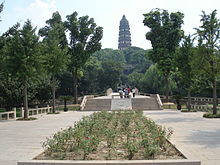- Huqiu Tower
-
The Huqiu Tower, or Yunyan Pagoda and Tiger Hill Pagoda,[1] (Chinese: 云岩寺塔; pinyin: Yún yán sì tǎ or Chinese: 虎丘塔; pinyin: Hŭ qiū tǎ) is a Chinese pagoda situated at Changmen in Suzhou City, Jiangsu Province. It has several other names, including the 'Leaning Tower of China' (as referred to by historian O.G. Ingles)[1] and the Yunyan Temple Tower. The tower was built in the later period of the Five Dynasties (907-960 CE), completed by the second year of the Song Dynasty. The tower rises to a height of 47 m (154 ft). It is a seven-story octagonal building built with blue bricks. In more than a thousand years the tower has gradually slanted due to forces of nature. Now the top and bottom of the tower vary by 2.32 meters. The entire structure weighs some 7,000,000 kilograms (15,000,000 lb), supported by internal brick columns.[2] However, the tower leans roughly 3 degrees due to the cracking of two supporting columns.[2]
The tower leans because the foundation is originally half rock and the other half is on soil. In 1957, efforts were made to stabilize the tower and prevent further leaning. Concrete was also pumped into the soil forming a stronger foundation. During the reinforcement process, a stone casket containing Buddhist scriptures was found. The container had an inscription noting the completion date of the tower as the seventeenth day of the twelfth month of the second year of the reign of Jianlong (961 AD); according to O.G Ingles it was built in 959.[2] O.G. Ingles writes that the better name for the Tiger Hill Pagoda should be the "'Leaning Tower of China', since it predates the famous Italian structure."[2] The uppermost stories of the tower were built as an addition during the reign of the Chongzhen Emperor (1628–1644), the last emperor of the Ming Dynasty.[2]
As of September 2010 public access to the top of the tower is no longer allowed.
Notes
References
- Ingles, O.G. "Impressions of a Civil Engineer in China," The Australian Journal of Chinese Affairs (Number 7, 1982): 141–150.
See also
- Leaning tower
- Chinese architecture
- Architecture of the Song Dynasty
Jiangsu topics General Geography Cities • Grand Canal of China • Yellow Sea • East China Sea • Xishan Island •
Yangtze River • Lake Tai • Hongze Lake • Yangcheng Lake • Huai RiverEducation Culture Visitor attractions Purple Mountain • Sun Yat-sen Mausoleum • Ming Xiaoling Mausoleum • Jiming Temple • Nanjing Yangtze River Bridge • Hanshan Temple • Huqiu Tower • Grand Buddha at Ling Shan • Chaotian Palace • Qixia Temple • Tianning Temple PagodaCoordinates: 31°20′17″N 120°34′35″E / 31.33806°N 120.57639°E
Categories:- Chinese architectural history
- Buildings and structures in Suzhou
- Chinese pagodas
- Inclined towers
- Buildings and structures completed in the 10th century
- Pagodas
Wikimedia Foundation. 2010.


